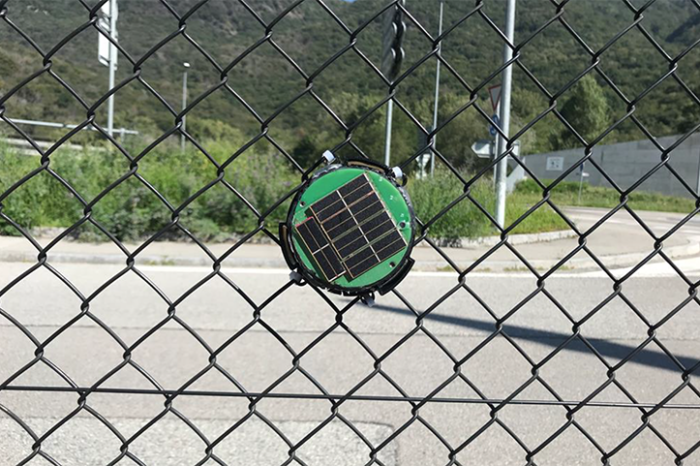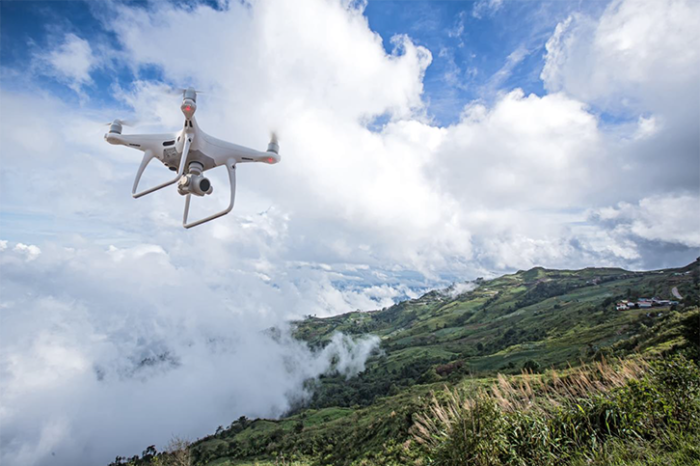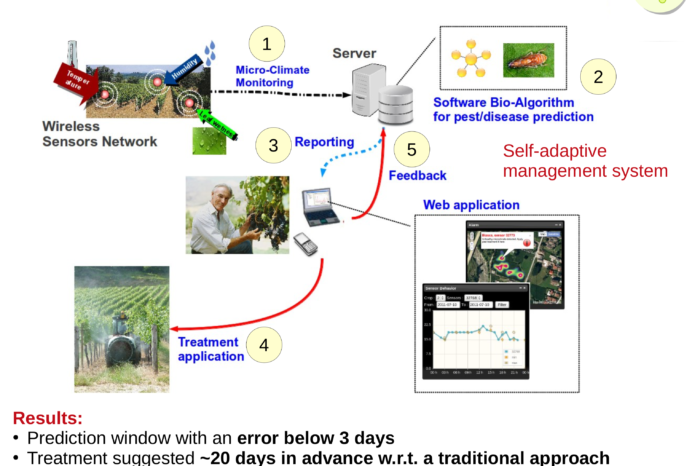Resources
Kit
Magazine
USI and SUPSI’s projects on wireless communication:
Below are some of the research projects on wireless developed at USI and SUPSI over the last few years:
SABIK Self powered anti-intrusion detection system
SUPSIThe problem: Increasingly buildings need to be equipped with security systems in order to avoid burglaries. Common systems rely on wired-connected sensors placed along the length of the fence’s or building’s perimeter. Available systems activate only in case of direct contact with the intrud-er and do not allow to detect the presence of people or objects in the close proximity. The project: The aim of the project is to achieve an innovative sensor-network able to detect not only burglary, but also the approaches of persons near the pro-tected area. Moreover every sensor will be energy self-sufficient so that no cable need to be installed. The result: SABIK overcome limitations of common detecting systems providing self-powered wireless-sensors, allow-ing to reduce maintenance costs. Fur-thermore, given that the communica-tion is adaptive, it will be possible to install the device easily on any kind of existent fences.
Project lead by Gian Carlo Dozio
Partner: Fratelli Albertolli SA
Funding agency: CTI, Commissione per la tecnologia e l’innovazione
ARVADOS Innovative system for missing people rescue
SUPSIThe problem: Nowadays rescue aid systems, especially for snow related research, are still in most of the cases using a single frequency beacon in order to help rescue people in finding avalanches victims. Such systems, despite the technology innovations in sensitivity and automated procedures, present limitations in distance and ease of use. The project: The project aims to develop a reliable missing people rescue device that takes advantage from the combination of multiple communication and location systems in a single product. The system will be fully retrocompatible with actual commercial ARVA system on the market adding new important improvement in the research procedure. The result: A portable or wearable integrated in a jacket rescue device that, thanks to the use of multiple communication and location technologies, permits an easier and effective location of lost people due to avalanches or others outdoor activities accident. The device could also be connected to a mobile phone in order to extend the possibility to use also cellular connections for data communication.
Project lead by Samuel Poretti Partner: DOS GROUP Funding agency: CTI, Commissione per la tecnologia e l’innovazione
DRONE Passive radio frequency drones detection
SUPSIThe problem The majority of actual drone detection systems present on the market are bulky and expensive. The project Development of a portable low cost passive drone detection device that will be mounted directly on aircrafts in order to warn pilots on the presence of a drone in their flying area. The result Thanks to the new device, pilots will be able to locate drones in advance and take all the necessary countermeasure in order to prevent aircraft crashes, saving human lives and reducing the losses due to cost for re-pairing it.
Project lead by Samuel Poretti
Partner: Swiss Helicopter SA, Flarm Technology AG
Funding agency: INNOSUISSE, Agenzia svizzera per la promozione dell’innovazione
Smart Vineyard: Wireless Sensor Network-based Adaptive Management System to Forecast Vineyard pests
USIThis project deals with the development of a Wireless-sensor-network-based adaptive Management System (WAMS) to prevent vineyard pests from reaching economically relevant densities. By means of a set of algorithms, the pilot system can represent current pest population and forecast its evolution at the vineyard and the regional level in Ticino, so to allow efficient pest control.
Project lead by Mauro Prevostini, program manager and lecturer at Faculty of Informatics.
Inventing European Wireless. A cultural history of wireless from point-to-point telegraphy to one-to-many broadcasting, 1903-1927
USIThis project studied the political, economic, and social construction of European wireless from the first international conference in which radiotelegraphy was considered (Berlin 1903) to the first in which radio broadcasting was definitely regulated (Washington 1927). Its methodological approach was based in the field of media history, with contributions from the political economy, economic history, international relations and institutions history, and finally audience studies in order to reconstruct the cultural history of two media (radiotelegraph and broadcasting) which emerged from one technology (wireless).
Researchers – Project lead by Gabriele Balbi, Associate Professor at the Faculty of Communication Sciences. Maria Rikitianskaia acted as collaborator and researcher.
HAMS: A Hybrid Approach to Malware Detection on Smartphones
USIInternet of Things devices make use of wireless connections. Being in the Internet, exposes them to different security attacks, the most common one being malicious software (Malware). Our team has been working on malware detection for smarphones and for IoT devices, by developing and testing novel and efficient detection methods.
Researchers – Miroslaw Malek, Director of Advanced Learning and Research Institute, and Ferrante Alberto, Lecturer and researcher of Faculty of Informatics.

Wi-com – Understanding motivations of wireless communities participants
USIIn collaboration with AIL, this project studied how people use the free municipal Wi-Fi network of the city of Lugano (“WiFi Lugano”), with the goal of understanding who the users of this network are and how it would be possible to offer an even more tailored and user-oriented service to them. By combining technical network data and user-provided data collected through a short survey place on the landing page of the Wi-Fi network it was possible to identify five different usage practices: two business-oriented ones, two tourism-oriented ones, and one reflecting the practices of locals.
Researchers – Project lead by Lorenzo Cantoni, full professor at the Faculty of Communication Sciences. Anna Picco Schwendener acted as collaborator and researcher.
Wireless continues to be a hot topic today and a source of controversy. Nowadays, in the world and in Switzerland, a public debate on 5G is growing. To find out more, follow these links:
- 1. The “International Commission on Non-Ionizing Radiation Protection” launched in 2018 a public consultation on the effects on the body and health implications of 5G: https://www.icnirp.org/en/frequencies/high-frequency/index.html
- 2. ITU (International Telecommunication Union), one of the main international organizations dealing with the regulation of telecommunications at a global level. Opportunities & Challenges for 5G: https://www.itu.int/en/ITU-D/Documents/ITU_5G_REPORT-2018.pdf
- 3. European Parliament. 5G Deployment in Europe, USA and Asia: http://www.europarl.europa.eu/RegData/etudes/IDAN/2019/631060/IPOL_IDA(2019)631060_EN.pdf
- 4. World Health Organization (WHO) and 5G: http://www.emfexplained.info/?ID=25913
- 1. Federal Council: Mobile radio frequencies for 5G awarded in Switzerland: https://www.admin.ch/gov/en/start/documentation/media-releases.msg-id-73916.html
- 2. Working Group of the Federal Office for the Environment (FOEN) on 5G: https://www.bafu.admin.ch/bafu/de/home/themen/elektrosmog/dossiers/5g-netze.html
- 3. Swiss Telecommunications Association (ASUT). Fact checking on the main accusations at 5G: https://www.swisscom.ch/dam/swisscom/en/about/news/2019/03/27-5g-mobile-technology-fact-check/5g-mobile-technology-fact-check.pdf
- 4. Online petition “STOP 5G”: https://www.openpetition.eu/ch/petition/online/stop-5g-in-switzerland
References
Pubblicazione, installazioni ed eventi correlati hanno tratto informazioni utili da vari libri e articoli scientifici. Diamo di seguito una piccola selezione per chi fosse interessato ad approfondire la storia e l’evoluzione del wireless.
Balbi, G. (2013). Wireless. Nascita, morte e resurrezione di un’idea. In D. Borrelli & M. Gravila (a cura di), Media che cambiano, parole che restano (pp. 245-256). Milano: Franco Angeli
Balbi, G., & Magaudda, P. (2014). Storia dei media digitali. Rivoluzioni e continuità. Roma-Bari: Laterza.
Briggs, A. (1961). The History of Broadcasting in the United Kingdom. Volume I: The Birth of Broadcasting. Oxford: Oxford University Press.
Drack, M.T. (2000). La radio et la télévision en Suisse: histoire de la Société suisse de radiodiffusion jusqu’en 1958. Baden: hier + jetzt.
Hu, T-H. (2015). A prehistory of the cloud. Cambridge: The MIT Press.
Hughes, M., & Bosworth, K. (Eds.). (2012). Titanic calling: Wireless communications during the great disaster. Oxford: The Bodleian Library.
Launiainen, P. (2018). A Brief History of Everything Wireless. How Invisible Waves Have Changed the World. Cham: Springer.
Lemstra, W., Hayes, V., & Groenewegen, J. (Eds.). (2011). The innovation journey of Wi-Fi: The road to global success. The Innovation Journey of Wi-Fi: The Road to Global Success. Cambridge: Cambridge University Press.
Mäusli, T. (a cura di), Voce e specchio. Storia della radiotelevisione svizzera di lingua italiana. Locarno: Armando Dadò.
Natale, S. (2016). Supernatural entertainments: Victorian spiritualism and the rise of modern media culture. University Park: Pennsylvania State University Press.
Ortoleva, P., Temporelli, M. (2010). Vedere lontano. La televisione dalla trasmissione meccanica al digitale. Milano: Museo nazionale della Scienza e della Tecnologia Leonardo da Vinci.
Raboy, M. (2016). Marconi: the man who networked the world. Oxford, New York: Oxford University Press.
Rikitianskaia, M. (2018). A transnational approach to radio amateurism in the 1910s. In G. Föllmer & A. Badenoch (Eds.), Transnationalizing radio research: new approaches to an old medium (pp. 133–140). Bielefeld: Transcript Verlag.
Sconce, J. (2000). Haunted Media. Electronic Presence from Telegraphy to Television. Durham: Londra.
Valsangiacomo, N. (2015). Dietro al microfono: Intellettuali italiani alla Radio svizzera (1930-1980). Bellinzona: Edizioni Casagrande.









